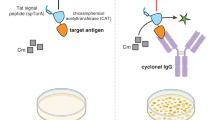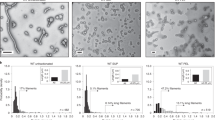Abstract
High level expression of the gene for human interferon-gamma (HuIFN-γ) in E. coli JM101 cultured at 37° C results in the distribution of over 90 percent of the total accumulated gene product into inclusion bodies (IBs). We have identified mutations throughout the molecule that alter the distribution between the soluble and inclusion body fractions without greatly affecting total expression level. Some mutants retain high biological activity but are localized almost entirely in the soluble fraction. Mutations affecting IB distribution as well as stability to intracellular proteolysis were detected by immunochemical screens and verified by gel assays. Immunochemical screens such as those employed here may allow identification of folding and stability mutants in heterologously expressed proteins when there is no other basis for selection or screening. These results also suggest that one solution to production problems arising from IB formation may be to identify mutations in the target protein that favor expression of soluble protein while retaining biological activity.
This is a preview of subscription content, access via your institution
Access options
Subscribe to this journal
Receive 12 print issues and online access
$209.00 per year
only $17.42 per issue
Buy this article
- Purchase on Springer Link
- Instant access to full article PDF
Prices may be subject to local taxes which are calculated during checkout
Similar content being viewed by others
References
Prouty, W.F. and Goldberg, A.L. 1972. Fate of abnormal proteins in E. coli: Accumulation in intracellular granules before catabolism. Nature 240: 147–150.
Prouty, W.F., Karnovsky, M.J. and Goldeberg, A.L. 1975. Degradation of abnormal proteins in Escherichia coli: Formation of protein inclusions in cells exposed to amino acid analogs. J. Biol. Chem. 250: 1112–1122.
Williams, D.C., Van Frank, R.M., Muth, W.L. and Burnett, J.P. 1982. Cytoplasmic inclusion bodies in Escherichia coli producing bio-synthetic human insulin proteins. Science 215: 687–689.
Wetzel, R. and Goeddel, D.V. 1983. Synthesis of polypeptides by recombinant DNA methods p. 1–64. In: The Peptides: Analysis, Synthesis, Biology. Meienhofer, J. and Gross, E. (Eds.). Academic Press, New York.
Gribskov, M. and Burgess, R.R. 1983. Overexpression and purification of the sigma subunit of E. coli RNA polymerase. Gene 26: 109–118.
Marston, F.A.O. and Hartley, D.L. 1990. Solubilization of protein aggregates. Methods in Enzymol. 182: 264–276.
Wetzel, R. 1991. Enhanced folding and stabilization of proteins by suppression of aggregation in vitro and in vivo. In: Protein Engineering—A Practical Approach. Rees, A. R., Sternberg, M. J. E. and Wetzel, R. (Eds.). IRL Press at Oxford University Press, Oxford.
Wetzel, R. 1991. Protein aggregation in vivo: Bacterial inclusion bodies and mammalian amyloid. In: Stability of Protein Pharmaceuticals: In Vivo Pathways of Degradation and Strategies for Protein Stabilization. Ahern, T. J. and Manning, M. C. (Eds.). Plenum Press, New York.
Haase-Pettingell, C.A. and King, J. 1988. Formation of aggregates from a thermolabile in vivo folding intermediate in P22 tailspike maturation; A model for inclusion body formation. J. Biol. Chem. 263: 4977–4983.
Krueger, J.K., Stock, A.M., Schutt, C.E. and Stock, J.B. 1990. Inclusion bodies from proteins produced at high levels in Escherichia coli p. 136–142. In: Protein Folding: Deciphering the Second Half of the Genetic Code, Gierasch, L. M. and King, J. (Eds). American Association for the Advancement of Science, Washington, D.C.
Chrunyk, B.A., Evans, J., Lilquist, J., Young, P.R. and Wetzel, R. 1991. Mutations in human interleukin 1-β alter the expression of the protein in inclusion bodies. J. Cell. Biochem. 15G: 190.
Fane, B., Villafane, R., Mitraki, A. and King, J. 1991. Identification of global suppressors for temperature sensitive folding mutants of the P22 tailspike protein. J. Biol. Chem. 261: In press.
Fane, B. and King, J. 1991. Intragenic suppressors of folding defects in the P22 tailspike protein. Genetics 127: 263–277.
King, J., Fane, B., Haase-Pettingell, C., Mitraki, A. and Villafane, R. 1990. Genetic analysis of polypeptide chain folding and misfolding in vivo, p. 59–78. In: Protein Design and the Development of New Therapeutics and Vaccines. Hook, J. B. and Poste, G. (Eds.). Plenum Press, New York.
Wetzel, R., Perry, L.J., Veilleux, C. and Chang, G. 1990. Mutational analysis of the carboxyl terminus of human interferon-γ. Protein Engineering 3: 611–623.
Wetzel, R., Perry, L.J., Mulkerrin, M.G., Veilleux, C. and Chang, G. 1990. Genetic, physical and chemical studies on the role of the carboxyl-terminal region of interferon-gamma, p 219–227. In: Protein Engineering '89: The Proceedings of the Second International Conference on Protein Engineering. Ikehara, M., Oshima, T. and Titani, K. (Eds.). Japan Scientific Societies Press, Tokyo.
Arakawa, T., Alton, N.K. and Hsu, Y.R. 1985, Preparation and characterization of recombinant DNA-derived human interferon-γ. J. Biol. Chem. 260: 14435–14439.
Taylor, G., Hoare, M., Gray, D.R. and Marston, F.A.O. 1986. Size and density of protein inclusion bodies. Bio/Technology 4: 553–557.
Hsu, Y.R., Ferguson, B., Narachi, M., Richards, R.M., Stabinsky, T., Alton, N.K., Stebbing, N. and Arakawa, T. 1986. Structure and activity of recombinant human interferon-γ analogs. J. Interferon Res. 6: 663–670.
Honda, S., Asano, T., Kajio, T., Nakagawa, S., Ikeyama, S., Ichimori, Y., Sugino, H., Nara, K., Kakinuma, A. and Kung, H.-F. 1987. Differential purification by immunoaffinity chromatography of two carboxy-terminal portion-deleted derivatives of recombinant human interferon-γ from Escherichia coli. J. Interferon Res. 7: 145–154.
Doebeli, H., Gentz, R., Jucker, W., Garotta, G., Hartmann, D.W. and Hochuli, E. 1988. Role of the carboxy-terminal sequence on the biological activity of human immune interferon (IFN-γ). J. Biotech. 7: 199–216.
Lee, S.G., Ricca, R.A., Crumley, G., Lloyd, R.S. and Drohan, W. . 1988. Modulation of expression of the human gamma interferon gene in E. coli by site-directed mutagenesis. Biochem. Biophys. Res. Comm. 151: 598–607.
Schein, C.H. and Noteborn, M.H.M. 1988. Formation of soluble recombinant proteins in Escherichia coli is favored by lower growth temperature. Bio/Technology 6: 291–294.
Schein, C.H. 1989. Production of soluble recombinant proteins in bacteria. Bio/Technology 7: 1141–1149.
King, J., Fane, B., Haase-Pettingell, C., Mitraki, A., Villafane, R. and Yu, M.-H. 1990. Identification of amino acid sequences influencing intracellular folding pathways using temperature-sensitive folding mutations, p. 225–240. In: Protein Folding: Deciphering the Second Half of the Genetic Code, Gierasch, L. M. and King, J. (Eds.). American Association for the Advancement of Science, Washington, D.C.
Ealick, S.E., Cook, W.J., Vijay-Kumar, S., Carson, M., Nagabhushan, T.L., Trotta, P.P. and Bugg, C.E. 1991. Three-dimensional structure of recombinant human interferon-γ. Science 252: 698–702.
Mulkerrin, M.G. and Wetzel, R. 1989. pH dependence of the reversible and irreversible thermal denaturation of γ interferons. Biochem. 28: 6556–6561.
Wilkinson, D.L. and Harrison, R.G. 1991. Predicting the solubility of recombinant proteins in Escherichia coli. Bio/Technology. 9: 443–448.
Rinderknecht, E. and Burton, L.E. 1985. Biochemical characterization of natural and recombinant IFN-gamma, p. 397–402. In: The Biology of the Interferon System, 1984. Kirschner, H. and Schellekens, H. (Eds.). Elsevier, Amsterdam.
Fane, B. and King, J. 1987. Identification of sites influencing the folding and subunit assembly of the P22 tailspike polypeptide chain using nonsense mutations. Genetics 117: 157–171.
Hogrefe, H.H., McPhie, P., Bekisz, J.B., Enterline, J.C., Dyer, D., Webb, D.S.A., Gerrard, T.L. and Zoon, K.C. 1989. Amino terminus is essential to the structural integrity of recombinant human interferon-γ. J. Biol. Chem. 264: 12179–12186.
Zavodny, P., Petro, M.E., Chiang, T.R., Narula, S.K. and Leibowitz, P.J. 1988. Alterations of the amino terminus of murine interferon-γ. expression and biological activity. J. Interferon Res. 8: 483–494.
Goldenberg, D. 1988. Genetic studies of protein stability and mechanisms of folding. Ann. Rev. Biophys. Biophys. Chem. 17: 481–507.
Coplen, L.J., Frieden, R.W. and Goldenberg, D.P. 1990. A genetic screen to identify variants of bovine pancreatic trypsin inhibitor with altered folding energetics. Proteins: Structure, Function, and Genetics 7: 16–31.
Wetzel, R., Perry, L.J., Mulkerrin, M.G. and Randall, M. 1990. Unfolding and inactivation: Genetic and chemical approaches to the stabilization of T4 lysozyme and interferon-gamma against irreversible thermal denaturation p. 79–115. In: Protein Design and the Development of New Therapeutics and Vaccines; Proceedings of the Sixth Annual Smith, Kline and French Research Symposium. Poste, G. and Hook, J. B. (Eds.). Plenum Press, New York.
Perry, L.J. and Wetzel, R. 1986. Unpaired cysteine-54 interferes with the ability of an engineered disulfide to stabilize T4 lysozyme. Biochem. 25: 733–739.
Matteucci, M.D. and Heyneker, H.L. 1983. Targeted random mutagenesis: the use of ambiguously synthesized oligonucleotides to mutagenize sequences immediately 5′ of an ATG codon. Nucleic Acids Res. 11: 3113–3122.
Hart, R.A. Rinas U. and Bailey, J.E. 1990. Protein composition of Vitreoscilla hemoglobin inclusion bodies produced in Escherichia coli. J. Biol. Chem. 265: 12728–12733.
Author information
Authors and Affiliations
Rights and permissions
About this article
Cite this article
Wetzel, R., Perry, L. & Veilleux, C. Mutations in Human Interferon Gamma Affecting Inclusion Body Formation Identified by a General Immunochemical Screen. Nat Biotechnol 9, 731–737 (1991). https://doi.org/10.1038/nbt0891-731
Received:
Accepted:
Issue Date:
DOI: https://doi.org/10.1038/nbt0891-731
This article is cited by
-
High level soluble expression, one-step purification and characterization of HIV-1 p24 protein
Virology Journal (2011)
-
Identification of a key functional region in harpins from Xanthomonas that suppresses protein aggregation and mediates harpin expression in E. coli
Molecular Biology Reports (2007)
-
How to find soluble proteins: a comprehensive analysis of alpha/beta hydrolases for recombinant expression in E. coli
BMC Genomics (2005)
-
Sequence determinants of protein aggregation: tools to increase protein solubility
Microbial Cell Factories (2005)



